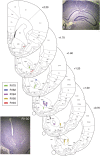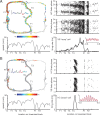Theta phase precession in rat ventral striatum links place and reward information
- PMID: 21414906
- PMCID: PMC3758553
- DOI: 10.1523/JNEUROSCI.4869-10.2011
Theta phase precession in rat ventral striatum links place and reward information
Abstract
A functional interaction between the hippocampal formation and the ventral striatum is thought to contribute to the learning and expression of associations between places and rewards. However, the mechanism of how such associations may be learned and used is currently unknown. We recorded neural ensembles and local field potentials from the ventral striatum and CA1 simultaneously as rats ran a modified T-maze. Theta-modulated cells in ventral striatum almost invariably showed firing phase precession relative to the hippocampal theta rhythm. Across the population of ventral striatal cells, phase precession was preferentially associated with an anticipatory ramping of activity up to the reward sites. In contrast, CA1 population activity and phase precession were distributed more uniformly. Ventral striatal phase precession was stronger to hippocampal than ventral striatal theta and was accompanied by increased theta coherence with hippocampus, suggesting that this effect is hippocampally derived. These results suggest that the firing phase of ventral striatal neurons contains motivationally relevant information and that phase precession serves to bind hippocampal place representations to ventral striatal representations of reward.
Figures












Similar articles
-
Reward Expectancy Strengthens CA1 Theta and Beta Band Synchronization and Hippocampal-Ventral Striatal Coupling.J Neurosci. 2016 Oct 12;36(41):10598-10610. doi: 10.1523/JNEUROSCI.0682-16.2016. J Neurosci. 2016. PMID: 27733611 Free PMC article.
-
Theta phase precession beyond the hippocampus.Rev Neurosci. 2012;23(1):39-65. doi: 10.1515/revneuro-2011-0064. Rev Neurosci. 2012. PMID: 22718612 Review.
-
Dissociation between the experience-dependent development of hippocampal theta sequences and single-trial phase precession.J Neurosci. 2015 Mar 25;35(12):4890-902. doi: 10.1523/JNEUROSCI.2614-14.2015. J Neurosci. 2015. PMID: 25810520 Free PMC article.
-
Enhancement of Hippocampal Spatial Decoding Using a Dynamic Q-Learning Method With a Relative Reward Using Theta Phase Precession.Int J Neural Syst. 2020 Sep;30(9):2050048. doi: 10.1142/S0129065720500483. Epub 2020 Aug 12. Int J Neural Syst. 2020. PMID: 32787635
-
Allocentric representations of space in the hippocampus.Neurosci Res. 2020 Apr;153:1-7. doi: 10.1016/j.neures.2019.06.002. Epub 2019 Jul 2. Neurosci Res. 2020. PMID: 31276699 Review.
Cited by
-
Reward Expectancy Strengthens CA1 Theta and Beta Band Synchronization and Hippocampal-Ventral Striatal Coupling.J Neurosci. 2016 Oct 12;36(41):10598-10610. doi: 10.1523/JNEUROSCI.0682-16.2016. J Neurosci. 2016. PMID: 27733611 Free PMC article.
-
Context, emotion, and the strategic pursuit of goals: interactions among multiple brain systems controlling motivated behavior.Front Behav Neurosci. 2012 Aug 3;6:50. doi: 10.3389/fnbeh.2012.00050. eCollection 2012. Front Behav Neurosci. 2012. PMID: 22876225 Free PMC article.
-
Theta oscillation and neuronal activity in rat hippocampus are involved in temporal discrimination of time in seconds.Front Syst Neurosci. 2015 Jun 22;9:95. doi: 10.3389/fnsys.2015.00095. eCollection 2015. Front Syst Neurosci. 2015. PMID: 26157367 Free PMC article.
-
Reinforcement learning using a continuous time actor-critic framework with spiking neurons.PLoS Comput Biol. 2013 Apr;9(4):e1003024. doi: 10.1371/journal.pcbi.1003024. Epub 2013 Apr 11. PLoS Comput Biol. 2013. PMID: 23592970 Free PMC article.
-
Space and Time: The Hippocampus as a Sequence Generator.Trends Cogn Sci. 2018 Oct;22(10):853-869. doi: 10.1016/j.tics.2018.07.006. Trends Cogn Sci. 2018. PMID: 30266146 Free PMC article. Review.
References
-
- Atallah HE, Lopez-Paniagua D, Rudy JW, O'Reilly RC. Separate neural substrates for skill learning and performance in the ventral and dorsal striatum. Nat Neurosci. 2007;10:126–131. - PubMed
-
- Bast T, Feldon J. Hippocampal modulation of sensorimotor processes. Prog Neurobiol. 2003;70:319–345. - PubMed
-
- Benchenane K, Peyrache A, Khamassi M, Tierney PL, Gioanni Y, Battaglia FP, Wiener SI. Coherent theta oscillations and reorganization of spike timing in the hippocampal-prefrontal network upon learning. Neuron. 2010;66:921–936. - PubMed
-
- Berke JD, Okatan M, Skurski J, Eichenbaum HB. Oscillatory entrainment of striatal neurons in freely moving rats. Neuron. 2004;43:883–896. - PubMed
Publication types
MeSH terms
Grants and funding
LinkOut - more resources
Full Text Sources
Miscellaneous
